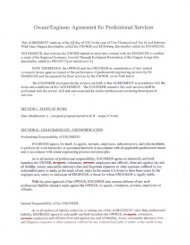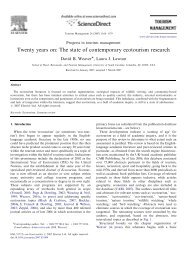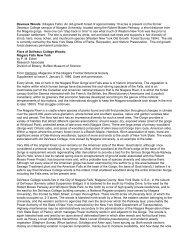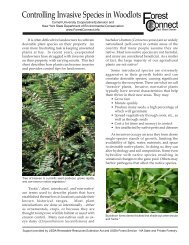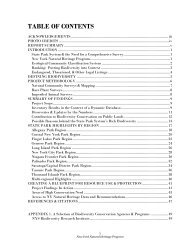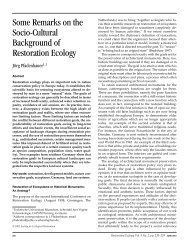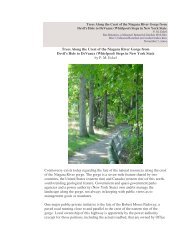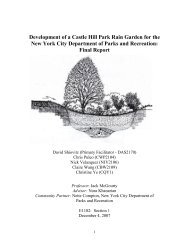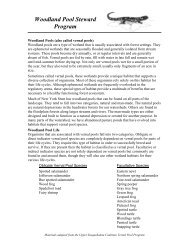All Anglers Non-Resident/Tourist AnglersCamping Gear $460,424,334 $17,772,173Binoculars $71,891,432 $6,790,111Special Fishing Clothing, Foul Weather Gear,Waders $329,188,489 $34,214,643Special Equipment Purchased for Fishing $17,353,409,220 $1,918,626,317Bass Boats $1,300,387,302 $299,628,231Other Motorized Boats $2,998,953,006 $524,440,937Canoes / Non-Motorized Boats $199,438,886 $12,045,692Boat Motors, Trailers, Hitches, <strong>and</strong> Accessories $1,243,547,634 $104,423,121Pick-ups, Campers, Travel Trailers, Motor Homes, etc. $7,221,153,483 $371,821,249Cabins $2,220,763,728 $557,116,8634x4 <strong>and</strong> Off-road Vehicles, Snowmobiles $1,954,960,575 $47,822,531Other Special Equipment $214,204,607 $1,327,693Other Miscellaneous Fishing Expenses $4,249,253,879 $1,249,147,026Taxidermy & Processing $41,298,946 $15,064,051Books <strong>and</strong> Magazines Devoted to Fishing $158,714,902 $13,053,004Dues <strong>and</strong> Contributions to Organizations $158,895,362 $14,567,340Fishing Licenses $597,210,000 $143,330,400Tags, Permits <strong>and</strong> Other Specialized Licenses $42,666,186 $9,760,016L<strong>and</strong> Owned Primarily for Fishing, 2001 expense only $2,992,008,447 $1,012,331,140L<strong>and</strong> Leased Primarily for Fishing, 2001 expense only $160,585,521 $41,041,076Other Misc. Fishing Related Expenditures $97,874,516 $35,025,508US Total $41,528,003,337 $7,257,892,205Source: American Sportfishing Association; Southwick Associates65
3.4 Travel <strong>and</strong> Tourism<strong>Parks</strong>, rivers <strong>and</strong> trails <strong>and</strong> greenways which attract visitors from outside the local area canstimulate the local economy. This section begins with examples stressing the importance <strong>of</strong>natural <strong>and</strong> cultural areas for attracting visitors, followed by examples showing how parks,rivers, trails, <strong>and</strong> greenways can contribute to the travel <strong>and</strong> tourism sectors throughspending by visitors to the communities around the park. The last subsection demonstrateshow park projects can leverage tourism appeal <strong>and</strong> increase marketing potential <strong>of</strong> a localcommunity.3.4.1 The Travel <strong>and</strong> Tourism IndustryThe travel <strong>and</strong> tourism industry is huge but not clearly delineated. Although there are manyreferences to the “travel” or “tourism” industry, neither is a clearly defined industry becausethe businesses that serve it do not provide a common product or service, nor do they use thesame technologies (Smith, 1997). Tourism is not listed as an <strong>of</strong>ficial industry in the CensusBureau’s St<strong>and</strong>ard Industrial Classification system, however, the following industrieswhich meet travelers’ needs are listed: hotel, restaurant, airline, automobile, shipping, retail<strong>and</strong> advertising industries. Thus, travel <strong>and</strong> tourism expenditures can be considered thosespent on transportation, lodging, eating establishments, retail, <strong>and</strong> service businesses. Suchspending, in turn, supports local jobs, personal income, <strong>and</strong> government tax revenues.Collectively, travel <strong>and</strong> tourism continue to grow, generating significant economic impacts<strong>and</strong> employment opportunities within regions <strong>and</strong> local communities.Travel <strong>and</strong> tourism is the first or second largest industry in many states <strong>and</strong> isexpected to soon be the leading industry worldwide. Tourism in the U.S. is a halftrilliondollars-a-year industry, employing more than 15.5 million people directly<strong>and</strong> indirectly (NPS, 1999).The U.S. travel industry received more than $554.5 billion from domestic <strong>and</strong>international travelers in 2003 (including international passenger fares). These travelexpenditures generated nearly 7.2 million jobs for Americans, with nearly $158billion in payroll income for Americans, as well as $94.7 billion in tax revenue forfederal, state <strong>and</strong> local governments. Furthermore, approximately 1 out <strong>of</strong> every 18U.S. residents in the civilian labor force was employed due to direct travel spendingin the U.S. in 2002 (TIA, 2004a).Tourism receipts, particularly on a per capita basis, can indicate how dependentstates or regions are on tourism. The West is the most tourism dependent region inthe United States, with ten <strong>of</strong> the 13 western states being among the 13 most tourismdependent states in the country. Nevada <strong>and</strong> Hawaii are the most tourism-dependentstates in the U.S. The importance <strong>of</strong> tourism in the West is also evident inemployment data. Nine <strong>of</strong> the 13 western states are among the top 13 states in thenation in share <strong>of</strong> total employment generated by domestic travel (Western StatesTourism Policy Council, 2002).66
- Page 1:
ECONOMIC IMPACTS OF PARKS, RIVERS,
- Page 4 and 5:
AcknowledgementsI am grateful to ma
- Page 6 and 7:
3.5.5 Sources of Information.......
- Page 8 and 9:
Table 28. Hiking/Walking Organizati
- Page 10 and 11:
1 IntroductionParks, rivers, trails
- Page 12 and 13:
Table 1.SectionAgency ExpendituresC
- Page 14 and 15:
provide communities with economic,
- Page 16 and 17:
the most current information on the
- Page 18 and 19:
3.1 Agency ExpendituresThis section
- Page 20 and 21:
grants. About 25% of capital expend
- Page 22 and 23:
The Marin Conservation Corps (MCC)
- Page 24 and 25: already been implemented and is ope
- Page 26 and 27: Table 5.Net Benefit Per Participant
- Page 28 and 29: WEST VIRGINIAWISCONSINEarthCorpsFed
- Page 30 and 31: contracts that gross over $800 mill
- Page 32 and 33: 3.2.2 Special EventsRevenue enhanci
- Page 34 and 35: park experience to an audience who
- Page 36 and 37: you have the opportunity to determi
- Page 38 and 39: Use good survey methods. The better
- Page 40 and 41: California. A Report to The Sierra
- Page 42 and 43: powered activities 3 , a participan
- Page 44 and 45: Table 11. 2003 Sport Footwear Purch
- Page 46 and 47: 3.3.4 Fish and Wildlife-Related Rec
- Page 48 and 49: EQUIPMENT AND OTHER EXPENSESTotal $
- Page 50 and 51: Table 17. Estimates of Retail Expen
- Page 52 and 53: Table 19. U.S. Ski & Snowboard Indu
- Page 54 and 55: and from services related to the Pa
- Page 56 and 57: o $60 million in Harris County, TX,
- Page 58 and 59: League ofAmericanBicyclistsNational
- Page 60 and 61: SportingGoodsManufacturersAssociati
- Page 62 and 63: necessarily better, especially in s
- Page 64 and 65: Perspective. Available at http://ww
- Page 66 and 67: o Washington: $209 milliono West Vi
- Page 68 and 69: Economic Output Retail Sales Salari
- Page 70 and 71: Economic Output Retail Sales Salari
- Page 72 and 73: Table 35. Economic Impact of Sportf
- Page 76 and 77: Table 37. Per Capita Travel Receipt
- Page 78 and 79: their decision to return in the fut
- Page 80 and 81: Table 39. Visitors and Spending in
- Page 82 and 83: 2003). Data from California Departm
- Page 84 and 85: over 2003, despite high gas prices,
- Page 86 and 87: management changes or actions are e
- Page 88 and 89: accommodations used, and other trip
- Page 90 and 91: http://www.ncdot.org/transit/bicycl
- Page 92 and 93: 3.5 Estimating the Effects of Spend
- Page 94 and 95: “leakage” of money from the reg
- Page 96 and 97: Keep in mind that multipliers are s
- Page 98 and 99: 3.5.4 How to Use These Rationales i
- Page 100 and 101: economy, only those expenditures th
- Page 102 and 103: For example, be aware of the differ
- Page 104 and 105: 3.6 Health Care and FitnessThis sec
- Page 106 and 107: active, approximately $575 million
- Page 108 and 109: already had one heart attacko Impro
- Page 110 and 111: uilt as part of sound policy to pro
- Page 112 and 113: accounting for 14 million disabilit
- Page 114 and 115: park amenities available or do not
- Page 116 and 117: National Coalitionfor PromotingPhys
- Page 118 and 119: 100% of all health benefits to a si
- Page 120 and 121: Pratt M, Macera CA, Wang G. 2000. H
- Page 122 and 123: costs than normal weight; moderate
- Page 124 and 125:
References for Additional Informati
- Page 126 and 127:
3.7 Benefit EstimationParks, rivers
- Page 128 and 129:
Table 47.Forecasted Average Benefit
- Page 130 and 131:
Table 48.CriteriaRecreationExperien
- Page 132 and 133:
people using carefully designed and
- Page 134 and 135:
special government funds for causes
- Page 136 and 137:
Loomis, J. B., and White, D.S. 1996
- Page 138 and 139:
Economic Assessment for the Necedah
- Page 140 and 141:
Commercial UsesExpenditures byResid
- Page 142 and 143:
Outcomes Expenditures by GGNRA mana
- Page 144 and 145:
local transportation admissions and
- Page 146 and 147:
3.8.8 Educational ValueWhile it may
- Page 148 and 149:
the same municipality that are furt
- Page 150 and 151:
that do require storm water managem
- Page 152 and 153:
Summary of ActionsSimilar to corpor
- Page 154 and 155:
3.9 Resource Book AppendicesSeveral
- Page 156 and 157:
6. Spending in the area. Please rep
- Page 158 and 159:
local economy aren’t bringing in
- Page 160 and 161:
4 ConclusionIn 1995, the National P



